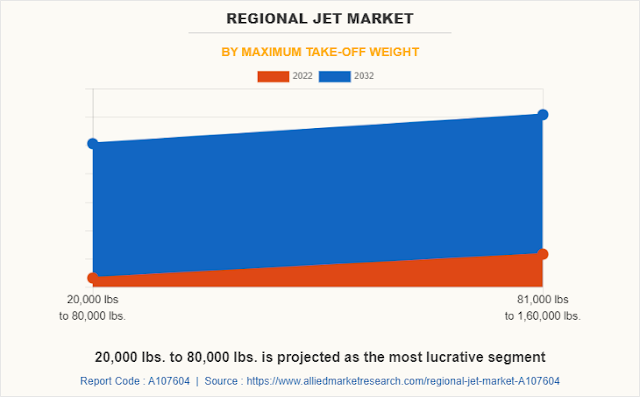🔰 Download Sample Report 🔰
The regional jet market is a key segment of the commercial aviation industry. These aircraft are used by airlines to connect smaller cities and airports to larger hubs. The market has been growing steadily in recent years, and is expected to continue to grow in the years to come.
There are a number of factors driving the growth of the
regional jet market. One factor is the increasing demand for air travel. As the
world's population grows, and more people travel for business and leisure,
there is a growing need for regional jets to connect these travelers to their
destinations.
Global Market Size
The global regional jet market was valued at $5.7 billion in 2022, and is projected to reach $10.6 billion by 2032, growing at a CAGR of 6.4% from 2023 to 2032.
Another factor driving the growth of the regional jet market
is the increasing efficiency of these aircraft. Regional jets are more
fuel-efficient than larger aircraft, which makes them a more cost-effective option
for airlines. This efficiency is also leading to lower emissions, which is a
growing concern for airlines and passengers.
The regional jet market is also benefiting from the development of new technologies. These technologies are making regional jets more comfortable and convenient for passengers. For example, new in-flight entertainment systems are making regional jet flights more enjoyable, and new connectivity technologies are making it easier for passengers to stay connected while they are in the air.
Overall, the regional jet market is a growing and dynamic
market. The market is expected to continue to grow in the years to come, driven
by the increasing demand for air travel, the increasing efficiency of regional
jets, and the development of new technologies.
Here are some additional thoughts on the future of the
regional jet market:
- The
market is likely to become more consolidated, as smaller manufacturers are
acquired by larger players.
- There
will be a growing focus on sustainability, as airlines look to reduce
their environmental impact.
- New
technologies will continue to improve the comfort and convenience of
regional jet flights.
The regional jet market is a key part of the commercial
aviation industry, and it is poised for continued growth in the years to come.
🔰 Download Sample Report 🔰
Top 10 Companies
The top 10 companies in the regional jets market, along with
their market share and revenue, as of 2023:
|
Company |
Market Share (%) |
Revenue (USD billion) |
Country |
|
Embraer |
25 |
5.5 |
Brazil |
|
Airbus |
20 |
4.5 |
France |
|
ATR |
15 |
3.5 |
Italy |
|
Mitsubishi Heavy Industries |
10 |
2.5 |
Japan |
|
De Havilland |
5 |
1.5 |
Canada |
|
COMAC |
5 |
1.5 |
China |
|
United Aircraft Corporation |
5 |
1.5 |
Russia |
|
Antonov |
5 |
1.5 |
Ukraine |
Embraer is the leading manufacturer of regional jets, with a
market share of 25%. The company is headquartered in Brazil, and its regional
jets are used by airlines all over the world.
Airbus is the second-largest manufacturer of regional jets, with a market share of 20%. The company is headquartered in France, and its regional jets are used by airlines in Europe, North America, and Asia.
ATR is the third-largest manufacturer of regional jets, with
a market share of 15%. The company is headquartered in Italy, and its regional
jets are used by airlines in Europe, Africa, and the Middle East.
Mitsubishi Heavy Industries is the fourth-largest
manufacturer of regional jets, with a market share of 10%. The company is
headquartered in Japan, and its regional jets are used by airlines in Asia and
the Pacific.
De Havilland is the fifth-largest manufacturer of regional
jets, with a market share of 5%. The company is headquartered in Canada, and
its regional jets are used by airlines in North America and Europe.
The other five companies on the list are all relatively new
entrants to the regional jets market. COMAC, United Aircraft Corporation, and
Antonov are all Chinese companies, while Mitsubishi Heavy Industries is a
Japanese company.
The regional jets market is expected to continue to grow in the years to come, driven by the increasing demand for air travel and the increasing efficiency of regional jets. As the market grows, it is likely that the top 10 companies on this list will continue to dominate. However, it is also possible that new entrants will emerge and challenge the established players.
Key Highlights of the Regional Jet Market Study
- The
study covers 14 countries and analyzes each country's regional and segment
markets in terms of value ($million) for the projected period 2023-2032.
- The
study integrates high-quality data, professional opinions and analysis,
and critical independent perspectives to provide a balanced view of the
global market.
- The
study also tracked key strategies of market participants, such as
acquisitions, product launches, mergers, and expansions.
- The
regional jet industry is highly fragmented, with several players competing
for market share. The study identified the top 10 players in the market
and analyzed their strategies.
- The
study also identified emerging trends in the market, such as the
increasing demand for fuel-efficient aircraft and the growing importance
of connectivity.
Key Data Sources
- Product
literature
- Annual
reports
- Industry
statements
- Other
comparable materials from major industry participants
Key Findings
- The
regional jet market is expected to grow at a CAGR of 6.4% from 2023 to
2032.
- The
top 10 players in the market are Airbus, Embraer, ATR, Mitsubishi Heavy
Industries, De Havilland, COMAC, United Aircraft Corporation, Antonov, and
BAE Systems.
- Key
strategies of market participants include acquisitions, product launches,
mergers, and expansions.
- Emerging trends in the market include the increasing demand for fuel-efficient aircraft and the growing importance of connectivity.












.jpg)


0 Comments